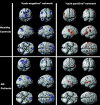Altered functional connectivity in early Alzheimer's disease: a resting-state fMRI study
- PMID: 17133390
- PMCID: PMC6871392
- DOI: 10.1002/hbm.20324
Altered functional connectivity in early Alzheimer's disease: a resting-state fMRI study
Abstract
Previous studies have led to the proposal that patients with Alzheimer's disease (AD) may have disturbed functional connectivity between different brain regions. Furthermore, recent resting-state functional magnetic resonance imaging (fMRI) studies have also shown that low-frequency (<0.08 Hz) fluctuations (LFF) of the blood oxygenation level-dependent signals were abnormal in several brain areas of AD patients. However, few studies have investigated disturbed LFF connectivity in AD patients. By using resting-state fMRI, this study sought to investigate the abnormal functional connectivities throughout the entire brain of early AD patients, and analyze the global distribution of these abnormalities. For this purpose, the authors divided the whole brain into 116 regions and identified abnormal connectivities by comparing the correlation coefficients of each pair. Compared with healthy controls, AD patients had decreased positive correlations between the prefrontal and parietal lobes, but increased positive correlations within the prefrontal lobe, parietal lobe, and occipital lobe. The AD patients also had decreased negative correlations (closer to zero) between two intrinsically anti-correlated networks that had previously been found in the resting brain. By using resting-state fMRI, our results supported previous studies that have reported an anterior-posterior disconnection phenomenon and increased within-lobe functional connectivity in AD patients. In addition, the results also suggest that AD may disturb the correlation/anti-correlation effect in the two intrinsically anti-correlated networks.
Wiley-Liss, Inc.
Figures


Similar articles
-
Altered resting state networks in mild cognitive impairment and mild Alzheimer's disease: an fMRI study.Hum Brain Mapp. 2005 Dec;26(4):231-9. doi: 10.1002/hbm.20160. Hum Brain Mapp. 2005. PMID: 15954139 Free PMC article.
-
Differentially disrupted functional connectivity of the subregions of the inferior parietal lobule in Alzheimer's disease.Brain Struct Funct. 2015 Mar;220(2):745-62. doi: 10.1007/s00429-013-0681-9. Epub 2013 Dec 1. Brain Struct Funct. 2015. PMID: 24292325
-
Regional functional connectivity predicts distinct cognitive impairments in Alzheimer's disease spectrum.Neuroimage Clin. 2014 Jul 23;5:385-95. doi: 10.1016/j.nicl.2014.07.006. eCollection 2014. Neuroimage Clin. 2014. PMID: 25180158 Free PMC article.
-
Impact of Alzheimer's disease on the functional connectivity of spontaneous brain activity.Curr Alzheimer Res. 2009 Dec;6(6):541-53. doi: 10.2174/156720509790147106. Curr Alzheimer Res. 2009. PMID: 19747154 Review.
-
Large-scale functional brain network abnormalities in Alzheimer's disease: insights from functional neuroimaging.Behav Neurol. 2009;21(1):63-75. doi: 10.3233/BEN-2009-0227. Behav Neurol. 2009. PMID: 19847046 Free PMC article. Review.
Cited by
-
Resting state functional MRI in Alzheimer's Disease.Alzheimers Res Ther. 2012 Jan 10;4(1):2. doi: 10.1186/alzrt100. Alzheimers Res Ther. 2012. PMID: 22236691 Free PMC article.
-
Fine-granularity functional interaction signatures for characterization of brain conditions.Neuroinformatics. 2013 Jul;11(3):301-17. doi: 10.1007/s12021-013-9177-2. Neuroinformatics. 2013. PMID: 23319242 Free PMC article.
-
Alterations in resting functional connectivity due to recent motor task.Neuroimage. 2013 Sep;78:316-24. doi: 10.1016/j.neuroimage.2013.04.006. Epub 2013 Apr 11. Neuroimage. 2013. PMID: 23583747 Free PMC article.
-
Altered hub configurations within default mode network following acupuncture at ST36: a multimodal investigation combining fMRI and MEG.PLoS One. 2013 May 17;8(5):e64509. doi: 10.1371/journal.pone.0064509. Print 2013. PLoS One. 2013. PMID: 23691237 Free PMC article.
-
A high-density multi-electrode platform examining the effects of radiation on in vitro cortical networks.Sci Rep. 2024 Aug 29;14(1):20143. doi: 10.1038/s41598-024-71038-6. Sci Rep. 2024. PMID: 39210021 Free PMC article.
References
-
- American Psychiatric Association ( 1994): DSM‐IV: Diagnostic and Statistical Manual of Mental Disorders, 4th ed Washington, DC: American Psychiatric Association.
-
- Azari NP, Rapoport SI, Grady CL, Schapiro MB, Salerno JA, Gonzales‐Aviles A, Horwitz B ( 1992): Patterns of interregional correlations of cerebral glucose metabolic rates in patients with dementia of the Alzheimer type. Neurodegeneration 1: 101–111.
-
- Backman L, Jones S, Berger AK, Laukka EJ, Small BJ ( 2005): Cognitive impairment in preclinical Alzheimer's disease: A meta‐analysis. Neuropsychology 19: 520–531. - PubMed
-
- Becker JT, Mintun MA, Aleva K, Wiseman MB, Nichols T, DeKosky ST ( 1996): Compensatory reallocation of brain resources supporting verbal episodic memory in Alzheimer's disease. Neurology 46, 692–700. - PubMed
Publication types
MeSH terms
LinkOut - more resources
Full Text Sources
Other Literature Sources
Medical

